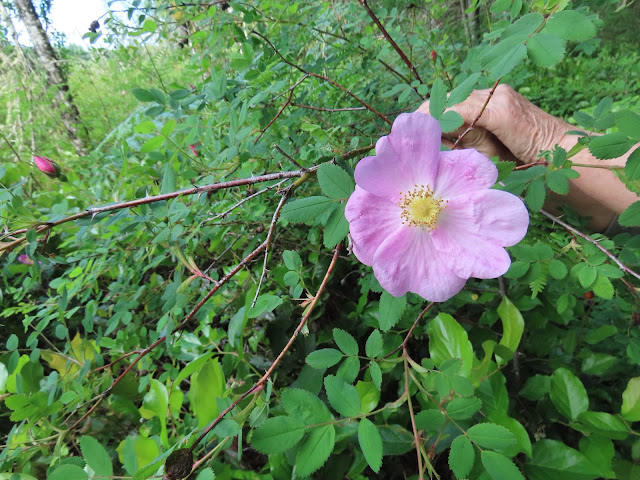4 June
--By way of a Guest Blog:
At the Christmas Potluck last December, Genevieve Singleton and I agreed to join together to lead an ANats walk in the Hamilton Wetlands and Forest at some time this year. We had worked together leading walks there for the BC Nature Annual General Meeting last May, and enjoyed our collaboration.
Genevieve's qualifications and training in botany are very strong. In addition, she has a true gift for leading and teaching visitors to natural environments. My claims to qualification are much more limited, arising from the not quite weekly frequency of visits to the area, and from the generosity of knowledgeable informants.
Meanwhile, I missed our walk yesterday due to a nasty bout of 'flu, but folks were nice enough to send lots of photos and accounts of their time together. Hence the Guest Blog.
Genevieve (also known as Jenny), began with a review of wildlife, including a formidable rack of elk antlers.
Photo by Bonnie Mullin
Elk are spotted in the Marsh, on occasion, although none were seen yesterday.The group gathered with Jenny, to hear of her years spent learning of the Forest and Wetlands.
Photo by Bonnie Mullin
At the entrance to the path, Toni pointed out a yew tree, not common in local forests.
Photo by Bonnie Mullin
And beyond the trailhead, Gary pointed out an even more uncommon Jack Pine.
Photos by Genevieve Singleton
This is a bit of a "Now you mention it," moment. How on earth have I missed seeing this quite distinctive tree over three years of visits? In any case, thanks to Gary (and a listing provided by Terry Taylor), we'll know it's there in future visits.
This cedar stump points to the history of the Forest. It was clearcut and burnt early in the 20th Century, but is re-vegetating splendidly.
More history: cascara looks to be making a comeback in the Forest after intensive harvesting of trees for bark to medicate troops in the First and Second World Wars.
photo by Genevieve Singleton
The Forest is in bloom at this season. Foamflower and vanilla leaf show along the path. Foamflower seems quite durable, and will be present for some weeks. The delicate spire arising from the vanilla leaf is less robust and will fade within weeks.
Siberian miner's lettuce starts out with white blossoms, but like trillium, develops a deep pink as it matures.
photo by Genevieve Singleton
Thimbleberry blossoms are abundant among the shrub's soft leaves.
Both types of wild rose are present in the Forest--both mostly nearer the edges of the Marsh.
The baldhip rose is less commonly found on the Island.
photo by Genevieve Singleton
The Nootka rose has more pronounced thorns.
photo by Bonnie Mullin
A cluster of salamander eggs beside the dock showed the symbiosis with algae that occurs with this species. Apparently the algae provides the developing eggs with oxygen in return for nitrogenous waste that fertilises the algae.
photo by Bonnie Mullin
Two tadpoles can also be seen by the egg mass.
The group gathered for a photo on the dock, serenaded by a marsh wren.
photo by Bonnie Mullin
photo by Ronda Murdock
Toni described the moment perfectly: "A Marsh Wren serenaded us the whole time we were at the dock. No one wanted to leave."
Truly a fine morning for friends to gather in a beautiful place.

















Comments
Post a Comment